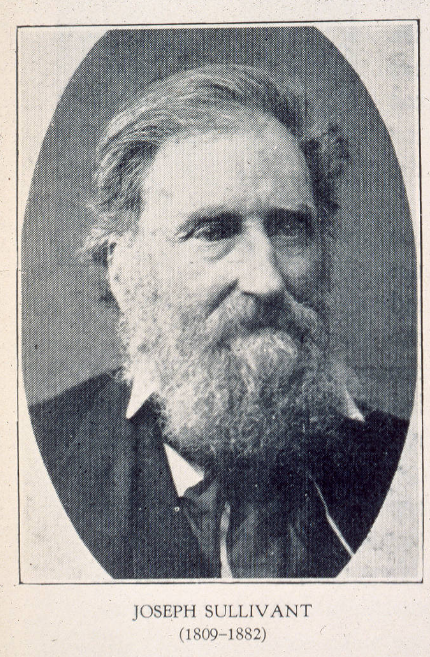Son of Franklinton's founder recounted 'marvelous changes' in Columbus after founding

- Oops!Something went wrong.Please try again later.
- Oops!Something went wrong.Please try again later.
On Saturday, June 3, 1871, a large group of people gathered in Columbus to hear local resident Joseph Sullivant present “An Historical Sketch relating to the Original Boundaries and Early Times of Franklin County.” The members and friends of the Franklin County Pioneer Association in attendance were treated to a lengthy address of several thousand words about the area’s history.
The youngest of the three sons of Lucas Sullivant, the founder of Franklinton, Joseph Sullivant was certainly one of the people who could tell that story.
Born in 1809, Joseph Sullivant had a long career as a supporter of local political, social and economic affairs, and was one of the original founders of Ohio State University.
He was also a man with decided opinions about his subject.
“A little less than 100 years ago, all this great western territory, now divided into many populous and flourishing states, was but a howling wilderness, almost unknown and untraversed by civilized man.” Now he said, he was pleased to deliver “a paper I have prepared for the occasion, which brings us together today; a day in which we propose to revive the memories of the past, to renew and strengthen the bonds of neighborly fellowship, and if possible, give our children some idea of the early times ...”
Meeting all of these needs would be a formidable task, but Sullivant spent the next several hours giving it his best effort. Recognizing that Native Americans had lived in Ohio for many years, Sullivant began his story as Great Britain struggled for control of the country north and west of the Ohio River in 1750.
“There are reasons for believing that even before 1750, there were white men who passed through this region. Christopher Gist, an agent of an English and Virginia land company, certainly traveled through this central region in 1750, and I have reasons for thinking he passed over or near the present site of Columbus …
“There were three (Native American) encampments or villages in this vicinity; one on the high bank near the old Morrill House, 1⅟₂ miles below the city … one at the west end of the Harrisburgh bridge, and the principal one on the river below the mouth of the Whetstone, near the Penitentiary (now the Arena District) …
“During the long contest between the French and the English for the possession of this great western territory, the (Native Americans) were the allies of France, and the western frontiers and border settlements of Pennsylvania and Virginia were constantly under attack.
“These incursions were continued after the fall of French power. … Accordingly, an army of 3,000 men was raised and equipped to operate against the (Native American) towns on the Scioto.
“This army marched in two divisions,” one of which under the command of Colonel Andrew Lewis engaged the Native Americans in a great battle near Point Pleasant, West Virginia. Surviving that battle and holding the battlefield, Lewis marched to the Pickaway Plains and joined with the army led by Lord Dunmore. The Native Americans sued for peace. That peace was brief, however, and the struggle for control of the Ohio country continued until the Greenville Treaty was signed by 13 tribes after the 1794 Battle of Fallen Timbers near Maumee in northwest Ohio.
In the wake of that battle, the opening of the Ohio country to commerce and white settlement began in earnest, with Columbus established as the new capital city across the Scioto River from Franklinton in 1812.
Sullivant continued, “at first our roads were mere traces in the woods … and I remember that wagons were stalled by the mud betwixt Franklinton and Columbus, and that they remained until they were dried out by the spring sun and winds.
“There was but little use for corn, for the cattle found subsistence in the abundant range, and hogs lived all winter in the woods … there are persons here today who can remember when there was not a sheep in Franklin County. … It was the prime object of the pioneers with many a sturdy stroke to slash down the grand old forests. … In spite of roots and stumps ... they contrived to reap sufficient crops to keep them well supplied with those great staples and comforts of pioneer life-hogs and hominy.
“What marvelous changes I have witnessed since I was a schoolboy, where myself … with others not now recollected, were careening around like young colts, in and out among the pawpaw bushes. … What times we had in summer with prisoner’s base, four holed cat, hopscotch, around the stakes and roley boley … with the hot blood coursing through our veins, we feared neither wind nor weather and experienced no sorrows that a night’s sound sleep would not dissipate.
“If all those who gathered with us in the old Columbus academy could have come together years afterward in the full flush of manhood, what a tale might have been told.”
On that June day in 1871, Joseph Sullivant made a good start of telling that story. He died on June 24, 1882, and is buried in Green Lawn Cemetery with his family and many of his friends.
Ed Lentz is a local historian and author who writes about Columbus-area history.
This article originally appeared on The Columbus Dispatch: Son of Franklinton's founder talked of opening of Ohio country
